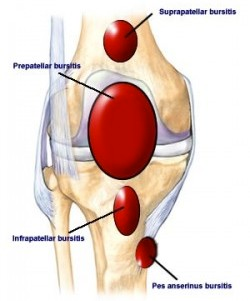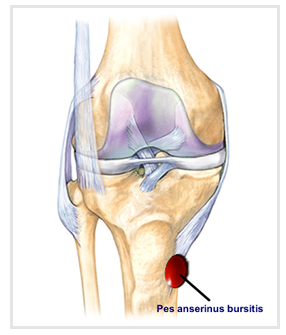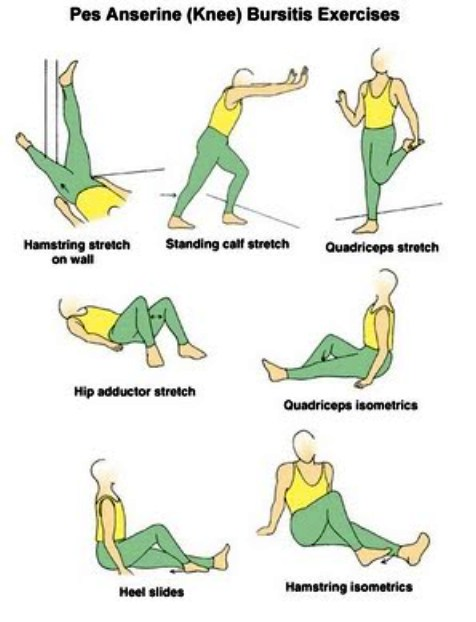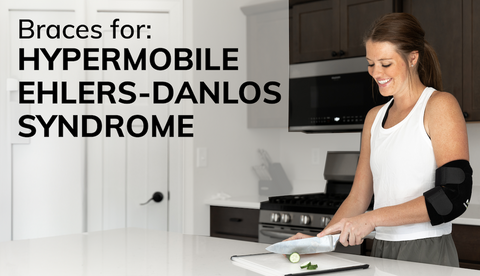Knee Bursitis Symptoms & Treatment
What is Bursitis of the Knee?
Knee bursitis is a condition in which one or more bursae in the knee become inflamed. Bursae are small fluid-filled sacs that help protect and soften the impact between tendons and bones. There are 11 knee bursae. The four most affected bursae of the knee are the suprapatellar bursa, prepatellar bursa, infrapatellar bursa, and the pes anserinus bursa. These four major bursae are shown in the knee bursitis picture diagram below:

If you have swelling and knee pain from bursitis may be the culprit. Bursitis knee pain can occur when in a stationary position or bending the knee. Someone affected by knee bursitis will find kneeling causes great pain. Knee bursitis is commonly caused by injuries to the patellar region, such as a fall or direct hit or blow to the kneecap. High impact injuries like these cause the bursae to get irritated and create extra fluid. Bursitis can happen to both the left or right knee, even though you can get right knee bursitis without having the left knee affected and vice versa. The location of where you get bursitis is dependent on which bursa is inflamed.
Pes Anserine Bursitis
Pes Anserine Bursitis is the same as anserine bursitis or pes bursitis and it affects the pes anserinus bursa. This bursa is located on the medial (or inner) side of the knee below the knee joint and close to the front of the knee, making it susceptible to injury. When the bursa gets irritated it will get inflamed and turn into pes anserine bursitis. When it comes to pes anserine bursitis running is the activity most associated with it, but it can also be caused by sports activities, obesity, and osteoarthritis. A tight hamstring is normally an underlying factor that affects the pes anserine bursa. To relieve tight hamstring and thigh muscles, try wearing a hamstring support sleeve.
Treatment for pes anserine bursitis is relatively simple. Many times anserine bursitis treatment combines stretching of the hamstring, icing, physical therapy, and patience to let it heal. A pes anserine bursitis knee brace can be helpful to reduce swelling, but no bulky brace is needed, just a knee sleeve will work. Nonsteroidal anti-inflammatory drugs or NSAIDs can be used to help with pes anserine bursitis. Anserine bursitis like other bursitis may require knee surgery in rare occasions. With surgery generally, the pes anserine bursa will be removed and then the patient will be assigned to physical therapy. Of course, before any treatment for pes anserine bursitis is done it is important to get the area of pain looked at by a professional to see if it is anserine bursitis or a different problem in the knee.

What is the Bursae of the Knee?
Knee bursae are small fluid-filled sacs that are scattered around the knee. There are 11 bursae in the knee. The knee bursae sac purpose is to keep tendons from rubbing against bone or other tendons. Bursitis comes from a bursa in the knee getting irritated and producing more fluid than normal. The extra fluid causes the bursa to become inflamed and swell up. This knee bursa injury causes bursitis. Normally bursitis is associated with knee bursa pain and swelling in one or more locations in the knee. In some circumstances, the bursa may get infected which will be dealt with by medication.
What Causes Bursitis in the Knee
What causes knee bursitis? There are a few causes of knee bursitis.
- Most commonly knee bursitis is caused by a lot of pressure on the knees from continually kneeling. Kneeling every day for an extended amount of time puts a lot of pressure on the knees. Jobs that tend to be affected by knee bursitis are plumbers, gardeners, etc.
- Bursitis knee injuries in athletes can occur from sudden impact to the knee in high contact sports such as football and volleyball. When the knee is hit the bursae take a lot of the blow. Quick cuts and rotating the knee while the foot is planted can also cause knee bursitis such as in sports like soccer and skiing.
- Causes of pes anserine bursitis are similar. Pes anserine bursitis causes can be athletically caused such as tight cuts or having the hamstring tight while running. Other causes of pes anserine bursitis are obesity, osteoarthritis of the knee, or flat foot.
- An infection can also cause knee bursitis.
Depending on how the injury happens knee bursitis symptoms may either happen very quickly or grow worse over time.
Knee Bursitis Symptoms
Common symptoms of knee bursitis are swelling, tenderness, and warmth to the touch accompanied by pain. Pain in the knee whether it is moving or stationary is a very common bursitis knee symptom. Therefore if you have knee pain from bursitis may be the culprit. Symptoms of bursitis in the knee tend to vary from person to person and for some may be worse than for others. For instance, the amount of swelling, pain, or tenderness can vary depending on the person as can pain and tenderness. If infected the area may be hot.
Anserine bursitis symptoms are the same as any other bursitis. Symptoms of pes anserine bursitis include swelling, tenderness, pain, and warmth to the touch. The only difference between pes anserine symptoms and other bursitis symptoms are the location of the symptoms.
Treatment for Knee Bursitis and Pes Anserine Bursitis
Now the question is how to treat knee bursitis and what to do for knee bursitis. There are several different knee bursa treatments aimed at reducing the inflammation in the bursa sac, which leads to bursitis. These treatment methods can be used interchangeably for all kinds of knee bursitis from pes anserine bursitis treatment to suprapatellar bursitis treatment. However, before doing any treatment for bursitis of the knee it is important to contact your doctor to see what will be the best treatment for knee bursitis for you. The treatments are as follow:
1.) Knee Brace- a good knee brace or bursitis knee sleeve can help bring swelling down and add comfort while negating some pain in the injured knee.
2.) Medication- if the bursa is infected medication may be prescribed to help fight the infection.
3.) Therapy- physical therapy may be prescribed to help strengthen the knee from getting bursitis again and to help relieve pain.
4.) Corticosteroid Injection- a corticosteroid may be injected into the knee to get rid of inflammation. This may be done if typical treatments do not work.
5.) Aspiration- if regular treatments do not work the doctor may use a needle to extract fluid from the infected area.
6.) Surgery- if no other bursitis knee treatment works or the bursitis is chronic and severe, knee bursitis surgery may be done. During this surgery, the doctor will remove the affected bursa. After surgery, a patient will be sent to physical therapy for knee bursitis recovery.
Unless you have traumatic knee bursitis a natural treatment method should be tried first. Treatment for pes anserine and other knee bursitis is normally to stretch, ice, and to have patience with the healing process. A good guideline for recovery naturally is the RICE method, which stands for rest, ice, compression, and elevation. For any knee bursitis, these steps can be done. Elevating the knee and wearing a sleeve can also be beneficial in reducing the swelling of knee bursitis.
There is no quick fix to knee bursitis. Patience combined with treatments recommended by a doctor is the best remedy for bursitis of the knee. A big bulky brace is not needed with knee bursitis, but a comfortable compression knee brace for bursitis or knee sleeve can help reduce swelling of the affected bursa.
The Compression Athletic Knee Sleeve is a great sleeve for knee bursitis. This knee support for bursitis helps with mobility by increasing blood circulation, regulating temperature, and delivering a greater supply of oxygen to the injured area. The brace is lightweight, moisture wicking, and odor absorbing. Using the sleeve can help reduce swelling of injuries to the bursa sac.
Braceability also carries a number of other great knee braces and sleeves that can be useful in treating bursitis.
Exercises for Knee Bursitis & Pes Anserine Bursitis
Exercises for bursitis in the knee can also help to heal knee bursitis, but one should ask a doctor if knee bursitis exercises are fine to do according to the severity of the knee bursitis. If a doctor clears knee exercises for bursitis they can be used as a good method for knee bursitis recovery. However, it is recommended to get a list of exercises to do from a professional. Pes anserine bursitis exercises are also beneficial to recovery. A physical therapist will be able to recommend good pes anserine bursitis treatment exercises along with knee bursitis exercises.
The type of exercises for pes anserine bursitis and knee bursitis are as follow:
- Hamstring exercises
- Quadriceps exercises
- Calf exercises

The following are just a few of the many videos with exercises for knee bursitis found on YouTube:










